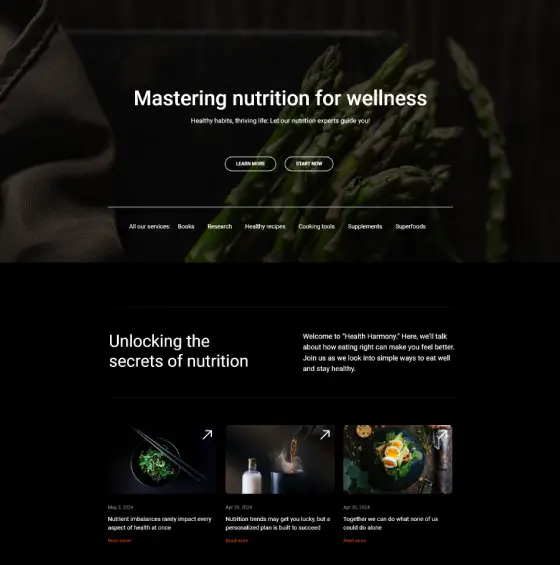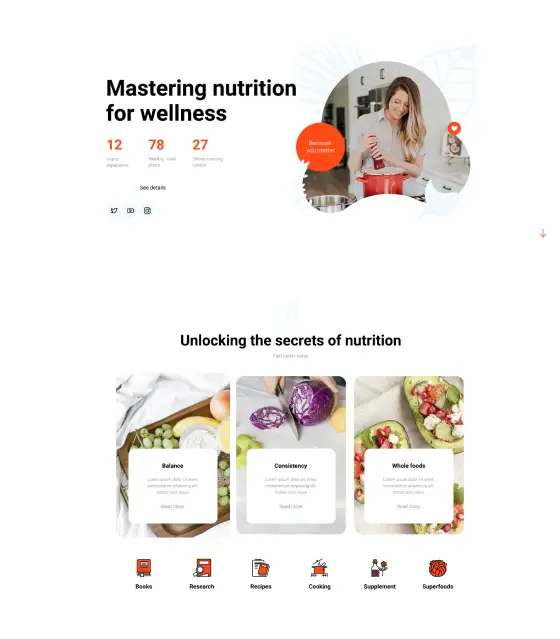
Website templates: Blog websites
Build WordPress sites with MaxiBlocks. All features free forever. No locked functionality. Optional Cloud Library saves you 10+ hours per project. Start free

beauty influencer website, Beaver Builder alternatives, best Elementor alternatives, best free WordPress themes, best influencer WordPress themes, best WordPress block templates, Best WordPress block themes, block design templates, block design themes, block editor compatible themes, block editor templates, block layout templates, block pattern examples, block style themes, block template library, block template plugin, block template themes, block-based website design, block-based WordPress theme, Brizy alternatives, content creator website template, creative block themes, custom block templates, custom block themes, custom Gutenberg blocks, customizable block themes, customizable free WordPress templates, customizable WordPress page builders, Divi Builder alternatives, Elementor alternatives, fashion influencer website, fast page builders for WordPress, free block templates for WordPress, free blog themes, free business WordPress themes, free directory themes, free eCommerce WordPress themes, free educational WordPress themes, free landing page templates, free multipurpose themes, free news and magazine themes, free one-page themes, free page builder plugins, free photography themes, free portfolio templates, free templates for WordPress, free WordPress block themes, free WordPress templates, Free WordPress themes, Gutenberg alternatives, Gutenberg block templates, Gutenberg block themes, influencer agency website, influencer collaboration website, influencer landing page, influencer marketing website, influencer network website, influencer portfolio website, influencer services website, influencer showcase website design, influencer website template, influencer WordPress theme, lifestyle blog template, lightweight block themes, lightweight free themes, lightweight page builders, modern block templates, modern block themes, multipurpose block themes, Oxygen Builder alternatives, page builder plugins for WordPress, personal brand website design, premium block templates for WordPress, premium block themes for WordPress, premium influencer WordPress theme, premium page builder alternatives, premium quality free themes, responsive block templates, responsive block themes, responsive free WordPress themes, responsive influencer website, responsive page builders, reusable block templates, SiteOrigin Page Builder alternatives, social media influencer website design, theme patterns for blocks, Thrive Architect alternatives, travel influencer website, user-friendly block templates, user-friendly block themes, user-friendly page builder plugins, versatile block templates, versatile block themes, visual page builder alternatives, WordPress, WordPress block templates, WordPress block theme, WordPress drag-and-drop builders, WordPress theme block templates, WPBakery Page Builder alternatives
Influencer Page IRP-PRO-01

Affiliate blog homepage, Beaver Builder alternatives, best Elementor alternatives, best WordPress block templates, Best WordPress block themes, block design templates, block design themes, block editor compatible themes, block editor templates, block layout templates, block pattern examples, block style themes, block template library, block template plugin, block template themes, block-based website design, block-based WordPress theme, Brizy alternatives, creative block themes, custom block templates, custom block themes, custom Gutenberg blocks, Custom WordPress homepage, customizable block themes, customizable WordPress page builders, Divi Builder alternatives, Elementor alternatives, fast page builders for WordPress, free block templates for WordPress, free page builder plugins, free WordPress block themes, Free WordPress themes, Gutenberg alternatives, Gutenberg block templates, Gutenberg block themes, lightweight block themes, lightweight page builders, modern block templates, modern block themes, multipurpose block themes, Oxygen Builder alternatives, page builder plugins for WordPress, premium block templates for WordPress, premium block themes for WordPress, premium page builder alternatives, responsive block templates, responsive block themes, responsive page builders, Responsive WordPress design, reusable block templates, SiteOrigin Page Builder alternatives, theme patterns for blocks, Thrive Architect alternatives, user-friendly block templates, user-friendly block themes, user-friendly page builder plugins, versatile block templates, versatile block themes, visual page builder alternatives, WordPress block templates, WordPress block theme, WordPress block themes, WordPress drag-and-drop builders, WordPress homepage customization, WordPress homepage design, WordPress patterns, WordPress theme block templates, WordPress website design, WPBakery Page Builder alternatives
Affiliate Blog ABP-PRO-01

Affiliate blog homepage, Beaver Builder alternatives, best Elementor alternatives, best WordPress block templates, Best WordPress block themes, block design templates, block design themes, block editor compatible themes, block editor templates, block layout templates, block pattern examples, block style themes, block template library, block template plugin, block template themes, block-based website design, block-based WordPress theme, Brizy alternatives, creative block themes, custom block templates, custom block themes, custom Gutenberg blocks, Custom WordPress homepage, customizable block themes, customizable WordPress page builders, Divi Builder alternatives, Elementor alternatives, fast page builders for WordPress, free block templates for WordPress, free page builder plugins, free WordPress block themes, Free WordPress themes, Gutenberg alternatives, Gutenberg block templates, Gutenberg block themes, lightweight block themes, lightweight page builders, modern block templates, modern block themes, multipurpose block themes, Oxygen Builder alternatives, page builder plugins for WordPress, premium block templates for WordPress, premium block themes for WordPress, premium page builder alternatives, responsive block templates, responsive block themes, responsive page builders, Responsive WordPress design, reusable block templates, SiteOrigin Page Builder alternatives, theme patterns for blocks, Thrive Architect alternatives, user-friendly block templates, user-friendly block themes, user-friendly page builder plugins, versatile block templates, versatile block themes, visual page builder alternatives, WordPress, WordPress block templates, WordPress block theme, WordPress block themes, WordPress drag-and-drop builders, WordPress homepage customization, WordPress homepage design, WordPress patterns, WordPress theme block templates, WordPress website design, WPBakery Page Builder alternatives
Affiliate Blog ABP-PRO-02
No content found
No content found
No content found
No content found
No content found
No content found
No content found
No content found
No content found
No content found
No content found
No content found
Get Cloud Library
From zero to income: A comprehensive guide to creating and monetising your blog
Welcome to the journey of creating and monetising a blog. Blogging has become a popular way for individuals to share their passions, ideas, and expertise with the world. It offers a platform to connect with like-minded people and, for many, has evolved into a viable source of income.
This book is designed to guide web designers, developers, and website creators through the entire process of setting up a successful blog. From understanding the basics of blogging to implementing advanced monetisation strategies, each section provides practical advice and actionable steps.
Whether the aim is to share personal stories, provide expert insights, or build a community around a specific niche, this guide covers all the essential aspects needed to create a thriving blog. By the end of this book, creators will have the knowledge and tools to launch their blog and turn it into a sustainable venture.
Understanding blogging
What is a blog?
A blog is a website that features regularly updated content, typically written in an informal or conversational style. It serves as a platform for sharing information, opinions, and experiences on a wide range of topics.
The evolution of blogging
Blogging has come a long way since its inception in the late 1990s. Initially, blogs were simple personal journals, but over time, they have transformed into powerful tools for communication, marketing, and even e-commerce.
The role of blogs today
In the current digital landscape, blogs play a significant role in content marketing, SEO strategies, and building online communities. They offer valuable content that attracts visitors, engages them, and encourages them to take action, whether it’s subscribing to a newsletter or making a purchase.
Benefits of blogging
Blogging offers numerous benefits, including:
- Building authority: Sharing expertise on a subject establishes credibility and authority.
- Connecting with others: Blogs create opportunities to engage with a global audience.
- Generating income: Various monetisation methods can turn a blog into a profitable venture.
- Personal growth: Writing regularly helps improve communication skills and knowledge in specific areas.
Planning your blog
Identifying your passion and niche
Choosing a niche that aligns with personal interests and expertise is crucial. A well-defined niche helps attract a targeted audience and differentiates the blog from others.
- Assessing interests and expertise: Reflect on topics that are both enjoyable and within one’s knowledge base.
- Market research and demand analysis: Investigate what audiences are searching for and identify gaps in existing content.
Defining your target audience
Understanding who the blog is for helps tailor content to meet their needs and preferences. Consider factors such as age, interests, and online behaviour.
Setting clear goals and objectives
Establishing specific goals provides direction and helps measure the blog’s success. Goals might include increasing website traffic, building an email list, or generating income through various channels.
Crafting your brand identity
A strong brand identity makes the blog memorable and appealing.
- Blog name and domain selection: Choose a name that reflects the blog’s focus and is easy to remember.
- Logo design and branding elements: Create a logo and select colours and fonts that represent the blog’s personality.
- Establishing your voice and tone: Decide how the blog will communicate with its audience, whether it’s formal, casual, or somewhere in between.
Setting up your blog
Choosing the right blogging platform
Selecting the appropriate platform is the first step in setting up a blog. WordPress websites are a popular choice due to their flexibility and extensive range of themes and plugins, making them suitable for anyone interested in building a robust online presence.
- Overview of popular platforms: WordPress, Blogger, Wix, and others each have their strengths and weaknesses. For a detailed comparison, check out the best open-source website builders in 2024.
- Self-hosted vs. hosted solutions: Self-hosted platforms like WordPress.org offer more control and customisation compared to hosted solutions like WordPress.com.
Selecting a web hosting service
A reliable hosting service ensures the blog is accessible and performs well.
- Key features to consider: Look for uptime reliability, customer support, and scalability to accommodate growth.
- Comparing top hosting providers: Companies like Bluehost, SiteGround, and HostGator are popular choices among bloggers.
- Budgeting for your blog: Understanding the cost to design a website on WordPress can help you plan your expenses effectively.
Registering a domain name
A domain name is the blog’s address on the internet.
- Tips for an effective domain: Keep it short, memorable, and relevant to the blog’s content.
- Domain registration process: Use registrars like GoDaddy or Namecheap to secure the chosen domain.
Installing and configuring your blogging platform
Setting up WordPress involves a few steps:
- Step-by-step installation guide: Most hosting providers offer one-click WordPress installations.
- Essential settings and configurations: Adjust settings such as permalinks, reading preferences, and discussion options.
- Getting started with WordPress: For beginners, this guide can help you navigate the initial setup.
Choosing and customising a theme
The theme determines the blog’s appearance and layout.
- Free vs. premium themes: Free WordPress themes offer basic features, while premium themes provide advanced customisation options.
- Customisation best practices: Modify colours, fonts, and layouts to match the brand identity without compromising usability. Using a WordPress website designer can help achieve a professional look.
- Ensuring mobile responsiveness: Select a theme that looks good on all devices, providing a consistent experience for visitors by focusing on responsive WordPress design.
- Exploring WordPress block themes: WordPress block themes offer flexibility and responsiveness, making it easier to customise your site.
Essential plugins and tools
Plugins extend the functionality of a WordPress site.
- SEO optimisation plugins: Tools like Yoast SEO help improve search engine rankings.
- Security and backup solutions: Plugins such as Wordfence and UpdraftPlus protect the blog from threats and ensure data is backed up.
- Performance enhancement tools: Caching plugins like W3 Total Cache speed up the site.
- Social sharing and engagement plugins: Enable easy content sharing and interaction with visitors.
- Enhancing content creation: Gutenberg blocks can help you build rich content layouts with ease.
- Block compatible themes and plugins: Consider block compatible themes and plugins to enhance your site’s capabilities.
Setting up core pages
Core pages provide essential information to visitors.
- About me page: Introduce the blog creator and the blog’s purpose.
- Contact page: Offer ways for visitors to get in touch.
- Privacy policy and terms of service: Inform visitors about data usage and legal terms.
- Efficient page creation: Use WordPress block templates to create these pages efficiently.
Creating compelling content
Developing a content strategy
A well-planned content strategy ensures consistent and relevant content.
- Content planning and editorial calendars: Organise topics and publishing schedules to maintain regular updates.
- Balancing evergreen and trending topics: Combine timeless content with current trends to attract a steady flow of visitors.
- Effective content management: Getting started with WordPress can help you learn how to create and manage your content effectively.
Crafting engaging blog posts
Creating content that captures and holds attention is essential.
- Writing attention-grabbing headlines: Use clear and intriguing titles to draw readers in.
- Structuring posts for readability: Break content into sections with headings, bullet points, and short paragraphs.
- Incorporating storytelling techniques: Use narratives to make content more relatable and memorable.
- Streamlining layouts: Utilise WordPress patterns page templates to enhance your post designs.
Utilising multimedia content
Enhancing blog posts with various media types can improve engagement.
- Incorporating images and graphics: Use relevant visuals to support the text and make the blog more appealing.
- Creating and embedding videos: Videos can explain complex topics and keep visitors on the site longer.
- Podcasting basics: Adding audio content can reach audiences who prefer listening over reading.
- Access to quality icons: Consider using the WordPress icon library for high-quality icons.
Search engine optimisation (SEO) basics
Optimising content for search engines increases visibility.
- Keyword research techniques: Identify the terms people are searching for and incorporate them naturally into content.
- On-page SEO best practices: Use keywords in titles, headings, and throughout the content without overstuffing.
- Meta tags and descriptions: Write concise and descriptive meta information to improve click-through rates from search results.
Content quality and originality
High-quality, original content builds trust and authority.
- Avoiding plagiarism: Ensure all content is original or properly attributed.
- Fact-checking and credibility: Verify information to maintain accuracy and reliability.
- Editing and proofreading tips: Review content for errors and clarity before publishing.
Growing your audience
Understanding your audience analytics
Analytics provide insights into who is visiting the blog and how they interact with content.
- Setting up Google Analytics: Install and configure Google Analytics to track visitor behaviour.
- Interpreting key metrics: Understand metrics like page views, bounce rate, and average session duration to gauge performance.
- Improving user experience: WordPress navigation menus can enhance site navigation and keep visitors engaged.
Social media marketing strategies
Leveraging social media can drive traffic to the blog.
- Selecting the right platforms: Choose platforms where the target audience is most active.
- Building a social media presence: Create and maintain profiles that reflect the blog’s brand.
- Content promotion tactics: Share blog posts, engage with followers, and use hashtags to increase reach.
Building an email list
Email marketing is a powerful tool for maintaining engagement with visitors.
- Importance of email marketing: It allows direct communication with the audience and can drive repeat visits.
- Lead magnets and sign-up forms: Offer incentives like free eBooks or exclusive content to encourage sign-ups.
- Crafting effective newsletters: Provide valuable content and updates to keep subscribers interested.
Networking and community engagement
Building relationships with others in the blogging community can enhance growth.
- Engaging with readers through comments: Respond to comments to foster a sense of community.
- Participating in online communities and forums: Join relevant groups to share expertise and attract visitors.
- Collaborating with other bloggers: Partner with others for guest posts or joint projects to reach new audiences.
- Organising content effectively: Use submenus in WordPress navigation to structure your site.
Leveraging SEO for organic traffic
Advanced SEO techniques can further increase visibility.
- Advanced keyword strategies: Target long-tail keywords and related terms to capture more specific searches.
- Link building techniques: Acquire backlinks from reputable sites to improve search engine rankings.
- Technical SEO considerations: Ensure the site is crawlable and free of technical issues that could hinder performance.
Paid advertising options
Investing in paid ads can accelerate audience growth.
- Google Ads and PPC campaigns: Use pay-per-click advertising to target specific keywords and demographics.
- Social media advertising: Promote content on platforms like Facebook, Instagram, and Twitter to reach a broader audience.
- Budgeting and ROI analysis: Allocate budget wisely and track the return on investment to ensure effectiveness.
Monetisation strategies
Affiliate marketing
Affiliate marketing involves promoting products and earning a commission for sales generated through referral links.
- Understanding how affiliate programs work: Join programs that align with the blog’s niche and audience.
- Selecting relevant affiliate products: Choose products that offer value to the audience and fit naturally within the content.
- Integrating affiliate links effectively: Place links in a way that feels natural and is not overly promotional.
- Disclosure and compliance: Clearly disclose affiliate relationships to maintain transparency and trust.
Display advertising
Displaying ads on the blog can generate income based on impressions or clicks.
- Introduction to ad networks: Join networks like Google AdSense or Media.net to access a range of advertisers.
- Optimising ad placement and formats: Position ads where they are likely to be seen without disrupting the reader’s experience.
- Managing user experience with ads: Balance ad density to avoid overwhelming visitors while maximising revenue.
Sponsored content and partnerships
Collaborating with brands for sponsored posts or partnerships can provide additional income streams.
- Attracting sponsorship opportunities: Build a strong blog presence to appeal to potential sponsors.
- Negotiating contracts and pricing: Set fair rates and terms that reflect the blog’s reach and influence.
- Maintaining authenticity and trust: Ensure sponsored content aligns with the blog’s values and audience interests.
Selling digital products
Creating and selling digital products can be a lucrative way to monetise expertise.
- Creating eBooks, courses, and webinars: Develop products that offer value and solve problems for the audience.
- Setting up an online store: Use platforms like WooCommerce to sell digital products directly from the blog.
- Marketing your products: Promote products through blog posts, email marketing, and social media to drive sales.
Offering services
Providing services related to the blog’s niche can diversify income streams.
- Consulting and coaching: Offer expert advice and personalised guidance to clients.
- Freelance writing and content creation: Provide content services to other businesses or individuals.
- Speaking engagements and workshops: Share knowledge through events and training sessions.
Membership and subscription models
Creating a membership area can provide exclusive content and benefits to subscribers.
- Creating exclusive content: Offer members-only articles, videos, or resources.
- Implementing membership platforms: Use tools like MemberPress to manage subscriptions and access.
- Pricing and retention strategies: Set competitive prices and provide ongoing value to keep members engaged.
Crowdfunding and donations
Encouraging supporters to contribute financially can supplement other income streams.
- Platforms like Patreon and Ko-fi: Use these platforms to collect donations or offer tiered support options.
- Engaging supporters and providing value: Show appreciation and offer rewards to donors to encourage ongoing support.
- Legal considerations: Ensure compliance with relevant laws and regulations when accepting donations.
Legal and ethical considerations
Understanding copyright laws
Respecting copyright is essential to avoid legal issues.
- Using images and content legally: Only use images and content that are owned, licensed, or properly attributed.
- Creative Commons and stock resources: Utilise resources that offer content under Creative Commons licenses or through stock libraries.
Privacy policies and terms of service
Clear policies inform visitors about how their data is used and protected.
- GDPR and CCPA compliance: Ensure the blog complies with data protection laws by implementing necessary measures.
- Protecting user data: Use secure methods to collect and store visitor information.
FTC guidelines and disclosures
Transparency in advertising and sponsorships maintains trust with the audience.
- Affiliate and sponsorship disclosures: Clearly disclose any relationships with affiliates or sponsors.
- Honest advertising practices: Promote products and services truthfully without misleading the audience.
Handling defamation and libel
Avoiding harmful statements is crucial to prevent legal issues.
- Avoiding legal pitfalls in content: Stick to factual information and avoid making unverified claims about individuals or entities.
- Responding to legal notices: Have a plan in place to address any legal concerns promptly and appropriately.
Accessibility standards
Making the blog accessible ensures it can be used by everyone, including those with disabilities.
- Making your blog accessible: Follow guidelines like WCAG to improve accessibility.
- Tools and plugins for accessibility: Use plugins that enhance accessibility features, such as screen reader support and keyboard navigation.
- Improving navigation: Implement dropdown menus best practices to enhance user experience.
Optimising and scaling your blog
Performance optimisation
A fast-loading blog improves user satisfaction and search engine rankings.
- Site speed enhancements: Use caching, optimise images, and minimise code to speed up the site. Consider using an AI website builder to streamline development.
- Image optimisation techniques: Compress images without sacrificing quality to reduce load times.
- Caching and CDN implementation: Implement caching solutions and use a Content Delivery Network to distribute content efficiently.
- Exploring alternatives: Check out Elementor alternatives for page building to improve site performance.
User experience (UX) improvements
Enhancing the blog’s usability makes it more enjoyable for visitors.
- Responsive design best practices: Ensure the blog looks good and functions well on all devices, implementing responsive WordPress design techniques.
- Navigation and site structure optimisation: Create clear and logical navigation to help visitors find content easily.
- Enhancing readability and engagement: Use readable fonts, appropriate colour contrasts, and engaging layouts to keep visitors interested.
Analysing data for growth
Data analysis helps identify areas for improvement and opportunities for growth.
- Advanced analytics and reporting: Use tools to gain deeper insights into visitor behaviour and content performance.
- Setting up goals and conversion tracking: Define specific actions you want visitors to take and track their completion.
- Heatmaps and user behaviour analysis: Visualise how visitors interact with the blog to identify popular areas and potential issues.
- Professional support: Consult WordPress website builders for advanced analytics solutions.
Outsourcing and team building
As the blog grows, delegating tasks can help manage the workload.
- Hiring freelancers and virtual assistants: Bring in help for tasks like content creation, design, or marketing.
- Delegating tasks effectively: Assign responsibilities based on team members’ strengths and expertise.
- Managing remote teams: Use communication and project management tools to coordinate efforts efficiently.
Diversifying content and platforms
Expanding the types of content and platforms used can reach new audiences.
- Expanding into video: Create a YouTube channel to complement the blog and attract video viewers.
- Launching a podcast: Offer audio content for those who prefer listening over reading.
- Repurposing content across channels: Adapt existing content for different formats and platforms to maximise reach.
- Leveraging free tools: Consider the benefits of an open source website builder for free websites when expanding your platform.
Case studies and success stories
Interviews with successful bloggers
Learn from those who have achieved success in the blogging world.
- Strategies they used to grow: Discover the methods and techniques that helped bloggers expand their audience and influence.
- Challenges they overcame: Understand the obstacles faced and how they were addressed to achieve success.
Monetisation examples across niches
Explore how different types of blogs generate income.
- Lifestyle blogs: See how bloggers in the lifestyle niche use affiliate marketing, sponsored posts, and product sales.
- Tech and review blogs: Learn about monetisation through tech reviews, affiliate links, and partnerships with tech companies.
- Niche hobby blogs: Discover how niche blogs use memberships, exclusive content, and specialised products to earn income.
Lessons learned from failures
Understanding common mistakes can help avoid similar pitfalls.
- Common mistakes to avoid: Identify errors that can hinder a blog’s growth and success.
- Turning setbacks into opportunities: Learn how to recover from failures and use them as learning experiences to improve the blog.
Staying ahead: Trends and the future of blogging
Emerging trends in content consumption
Stay updated with how content consumption is changing.
- Voice search and AI assistants: Optimise content for voice search and leverage AI tools for content creation.
- Augmented reality and VR content: Explore new ways to engage visitors with immersive technologies.
The impact of social media evolution
Adapt to changes in social media platforms and strategies.
- Microblogging and short-form content: Incorporate bite-sized content to cater to audiences with shorter attention spans.
- Influencer marketing shifts: Understand how influencer marketing is evolving and how to collaborate effectively.
Adapting to algorithm changes
Keep up with changes in algorithms that affect content visibility.
- SEO algorithm updates: Stay informed about search engine updates to maintain and improve rankings.
- Social media algorithm adjustments: Adjust social media strategies based on platform algorithm changes to maximise reach.
Continuous learning and development
Commit to ongoing education to stay competitive.
- Staying updated with industry news: Follow blogs, podcasts, and newsletters to keep abreast of the latest developments.
- Investing in professional development: Take courses, attend webinars, and participate in workshops to enhance skills and knowledge.
Resources and tools
Blogging platforms and services
Explore various platforms and services that support blogging efforts. WordPress is a leading choice, especially for those interested in WordPress website design.
Content creation and editing tools
Utilise tools that help create and refine content efficiently, such as WordPress block templates and WordPress templates.
SEO and marketing tools
Implement tools that enhance SEO and streamline marketing activities, including tools for optimising WordPress websites.
Recommended reading and courses
Access a curated list of books and courses for further learning and development.
Community and support networks
Join communities and networks that offer support, advice, and collaboration opportunities, such as the WordPress pattern library.
Conclusion
Creating and monetising a blog is an exciting journey that requires dedication, creativity, and continuous learning. By applying the knowledge and strategies outlined in this guide, you’re well on your way to building a successful blog that not only shares your passions with the world but also provides a sustainable income. Remember, persistence and adaptability are key—stay committed to your goals, embrace new trends, and watch your blog thrive.
Appendices
Glossary of blogging terms
Provide definitions for common blogging terminology to aid understanding.
Templates and checklists
Offer practical tools such as content calendar templates, blog post checklists, and SEO optimisation checklists to assist in the blogging process.
Legal document samples
Include samples of privacy policies, terms of service, and disclosure statements to help creators implement necessary legal measures.
Contact list of useful services and providers
Provide a list of recommended services and providers that can support various aspects of blog creation and management.


